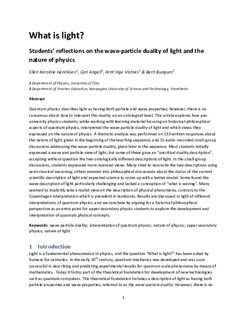| dc.contributor.author | Henriksen, Ellen Karoline | |
| dc.contributor.author | Angell, Carl | |
| dc.contributor.author | Vistnes, Arnt Inge | |
| dc.contributor.author | Bungum, Berit | |
| dc.date.accessioned | 2019-03-05T12:53:05Z | |
| dc.date.available | 2019-03-05T12:53:05Z | |
| dc.date.created | 2018-03-24T17:22:05Z | |
| dc.date.issued | 2018 | |
| dc.identifier.citation | Science & Education. 2018, 27 (1-2), 81-111. | nb_NO |
| dc.identifier.issn | 0926-7220 | |
| dc.identifier.uri | http://hdl.handle.net/11250/2588786 | |
| dc.description.abstract | Quantum physics describes light as having both particle and wave properties; however, there is no consensus about how to interpret this duality on an ontological level. This article explores how pre-university physics students, while working with learning material focusing on historical-philosophical aspects of quantum physics, interpreted the wave-particle duality of light and which views they expressed on the nature of physics. A thematic analysis was performed on 133 written responses about the nature of light, given in the beginning of the teaching sequence, and 55 audio-recorded small-group discussions addressing the wave-particle duality, given later in the sequence. Most students initially expressed a wave and particle view of light, but some of these gave an “uncritical duality description”, accepting without question the two ontologically different descriptions of light. In the small-group discussions, students expressed more nuanced views. Many tried to reconcile the two descriptions using semi-classical reasoning; others entered into philosophical discussions about the status of the current scientific description of light and expected science to come up with a better model. Some found the wave description of light particularly challenging and lacked a conception of “what is waving”. Many seemed to implicitly take a realist view on the description of physical phenomena, contrary with the Copenhagen interpretation which is prevalent in textbooks. Results are discussed in light of different interpretations of quantum physics, and we conclude by arguing for a historical-philosophical perspective as an entry point for upper secondary physics students to explore the development and interpretation of quantum physical concepts. | nb_NO |
| dc.language.iso | eng | nb_NO |
| dc.publisher | Springer Verlag | nb_NO |
| dc.title | What Is Light? Students’ Reflections on the Wave-Particle Duality of Light and the Nature of Physics | nb_NO |
| dc.type | Journal article | nb_NO |
| dc.type | Peer reviewed | nb_NO |
| dc.description.version | acceptedVersion | nb_NO |
| dc.source.pagenumber | 81-111 | nb_NO |
| dc.source.volume | 27 | nb_NO |
| dc.source.journal | Science & Education | nb_NO |
| dc.source.issue | 1-2 | nb_NO |
| dc.identifier.doi | 10.1007/s11191-018-9963-1 | |
| dc.identifier.cristin | 1575538 | |
| dc.relation.project | Norges forskningsråd: 246723 | nb_NO |
| dc.description.localcode | This is a post-peer-review, pre-copyedit version of an article published in Science & Education Locked until 21.03.2019 due to copyright restrictions. The final authenticated version is available online at: https://doi.org/10.1007/s11191-018-9963-1 | nb_NO |
| cristin.unitcode | 194,67,80,0 | |
| cristin.unitname | Institutt for lærerutdanning | |
| cristin.ispublished | true | |
| cristin.fulltext | postprint | |
| cristin.qualitycode | 1 | |
